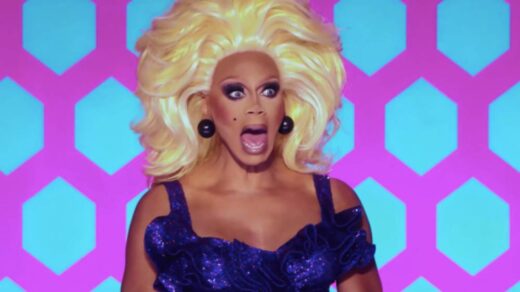How LGBTQ+ Excellence Helped Shape Broadway
Author: Trudy Ring

As the neon lights will soon shine bright on Broadway once again after an 18-month pandemic shutdown, it’s a good time to review how the famous New York thoroughfare has bounced back from previous crises.
That’s just what Oren Jacoby’s documentary On Broadway does. The film, opening in theaters Friday, looks at the past 50-some years of Broadway, how the productions and the neighborhood have changed over that time, and how Broadway has always come back from the brink of extinction.
It also makes clear that Broadway theater would not exist without the many LGBTQ+ people who have contributed their talents. It shines a spotlight on director-choreographer Michael Bennett, composer and lyricist Stephen Sondheim, director George C. Wolfe, actor-director-choreographer Tommy Tune, playwright Tony Kushner, actors Alexandra Billings and Ian McKellen, and more. “They’re part of the lifeblood of the American theater, and they have been since its inception,” says Jacoby, who describes himself as an ally.
Ian McKellen demonstrates the power of Broadway
The COVID-19 pandemic wasn’t on the radar yet when Jacoby started making the film. The documentary had its genesis when he was approached by Pat Schoenfeld, widow of Gerald Schoenfeld, who for many years was chairman of the Shubert Organization, the largest theater-owning business in the U.S. Gerald Schoenfeld, who died in 2008, had left an unfinished memoir that his wife thought would be a good basis for a film, telling the story of Broadway from the 1970s onward. And in the 2018-2019 season, Broadway had record attendance, so Jacoby figured the documentary could celebrate that. Then COVID hit, shutting down theaters.
“I think it has a lot more meaning today,” Jacoby says of the film, with the majority of Broadway shows set to reopen in September.
The documentary, of which Pat Schoenfeld is executive producer, starts by focusing on the late 1960s and early 1970s; Broadway audiences had declined by half between 1968 and 1972. That was partly because Broadway theater, especially musicals, seemed old-fashioned to a generation raised on rock and roll. But perhaps more important was the fact that people were afraid of the neighborhood. The Broadway theater district includes not just Broadway but many adjacent streets, and in that period the Times Square-42nd Street area was home to drug dealers, sex workers, and porn theaters. Police advised avoiding it after sundown.
The neighborhood’s transformation took several decades, but it’s now home to Disney-owned theaters, chain restaurants, and other family-friendly attractions. The “Disneyfication” of the area has many critics, who say it’s now too bland and commercial, and that marginalized people have been further marginalized. But Jacoby argues that the locale’s overhaul has been a good thing.
“Just having Disney on 42nd Street made families feel it was safe to come there,” he says, adding, “Broadway has always been a mixed bag of popular culture and art.”
But in the mid-1970s, long before Disneyfication, when the theater district was still gritty, came a show that rejuvenated Broadway artistically and commercially, an unlikely hit about dancers auditioning for a musical. A Chorus Line, conceived and staged by Michael Bennett, opened in 1975 to vast acclaim and held the record as the longest-running Broadway show until surpassed by another unlikely hit, Cats.
Other challenges lay ahead, though, including battles over the destruction of historic theaters, skyrocketing production costs (and ticket prices), periods of artistic moribundity, and the AIDS epidemic, which took Bennett’s life, along with the lives of many other Broadway figures. “We lost so many brilliant artists to AIDS,” Jacoby says.
But Broadway endured, and Jacoby’s film highlights the many creators who revitalized it artistically, commercially, or both — Bennett, Sondheim, Kushner, Wolfe, director-choreographer Bob Fosse, playwright August Wilson, composer Andrew Lloyd Webber, producer Cameron Mackintosh, playwright-composer Jonathan Larson, director Julie Taymor, and, most recently, multihyphenate Lin-Manuel Miranda of Hamilton fame. (Yes, women are still underrepresented in these positions.)
Jacoby also notes that while some observers see a lack of originality on Broadway, with producers going for “sure things” like jukebox musicals or re-creations of Disney films (although Taymor’s version of The Lion King showed how creatively that could be done), the shows that have really made a difference are ones that didn’t seem destined to be hits, from A Chorus Line to Cats to Rent to Hamilton.
Christine Baranski lends her signature sparkle to the documentary
He further details efforts to diversify Broadway, with offerings such as Angels in America, with Kushner exploring gay life and the devastation of AIDS; Wilson’s cycle of plays about Black Americans; and Hamilton’s use of hip-hop music and the casting of Black and Latinx actors as America’s founding fathers.
He also follows transgender actress Alexandra Billings through her rehearsals for and performance in her Broadway debut, 2018’s The Nap, a comedy in which she played Waxy Bush, a tough gangster who just happens to be a trans woman. “I wanted to do this particular show because Waxy’s transgenderism isn’t the crux of who she is, nor is it the crux of the play,” Billings says in the film. “She’s funny just because she’s funny, not because she’s transgender.”
Gay talents interviewed in the film include Wolfe, McKellen, and Tune, and there are interviews with many straight performers who are beloved by LGBTQ+ audiences, such as Christine Baranski, Helen Mirren, Hugh Jackman, and John Lithgow.
Jacoby is optimistic that Broadway theater will be open to further diversity in subject matter in casting, and that it will come back strong post-pandemic. “I hope the message of our film is that Broadway is needed by our society,” he says. “It’s come back before and it’ll come back again.”
And as McKellen says in the film, Broadway will speak to audiences, saying, “Come on, come in, come here. … I’m going to give myself to you and you’re going to come and love me.”
On Broadway opens Friday at Quad Cinema in New York City and will open August 27 at several Laemmle Theaters locations in Los Angeles, followed by a national rollout. Go to KinoMarquee.com to find a screening near you, and watch the trailer below.
Original Article on The Advocate
Author: Trudy Ring




